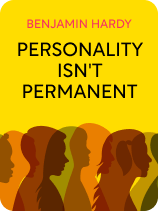

This article is an excerpt from the Shortform book guide to "Personality Isn't Permanent" by Benjamin Hardy. Shortform has the world's best summaries and analyses of books you should be reading.
Like this article? Sign up for a free trial here.
Do you want to know how to stop sabotaging yourself? What skills do you need to overcome self-sabotage?
Everyone has the potential to become the person they want to be. What’s blocking you is the self-sabotaging narratives you tell yourself about what you can and cannot do.
With this in mind, here’s how to stop sabotaging yourself by reframing self-limiting narratives.
Heal Yourself by Changing Unhealthy Narratives
In his book Personality Isn’t Permanent, Hardy says you can change your unhealthy narratives so they don’t block you from meeting your primary goal and becoming your optimal self. To do this, reshape your narratives to be in service of your future goal, choosing narratives that frame you in a positive light and as empowered.
We’ve synthesized Hardy’s advice on how to stop sabotaging yourself by changing your general unhealthy narratives into four main strategies: identify with your future self, focus on the positives, consider more of the context, and—specifically for healing traumatic narratives—share your trauma.
1) Identify With Your Future Self
Rather than thinking about yourself as the person who has your current limitations, think of yourself as the person who’s going to overcome these limitations—defining yourself based on who you will be, not who you’ve been. For instance, instead of thinking of yourself as someone who’s not confident and never has been, think of yourself as someone who will be confident in the near future. By identifying more with your future self than your current limitations, you see your limitations as temporary—and therefore feel empowered to overcome them. As a result, you feel more deeply that you can change, and you have greater hope and motivation.
(Shortform note: In addition to thinking about yourself in terms of your optimal self, the opposite—thinking about an undesired future self—is helpful too. When you imagine a future where you’ve failed to reach your primary goal, you’re likely to feel discomfort and anxiety. You can use these uncomfortable emotions as fuel to meet your goals. Since you feel motivated to avoid feeling this way in the future, you’ll feel more motivated to keep working toward your primary goal.)
2) Focus on the Positives
When an event happens to you that you wish hadn’t, it’s easy to tell yourself narratives that frame you as a disempowered victim of bad circumstances. But Hardy argues that no event is intrinsically good or bad—they all have positive and negative aspects.
By focusing on the positive aspects of events, it becomes easier to accept them. This helps you feel motivated and empowered to keep working toward your goal when things happen that would usually make you feel unmotivated and disempowered. Telling yourself narratives that focus on being grateful for the positives in a situation helps you see the negative aspects as less important and helps you feel less victimized. As a result, you can more easily recover from a negative experience without losing momentum or hope.
For example, if your car breaks down, your gut reaction might be to tell yourself the narrative that this is an awful event that will ruin your day and get in the way of working on your goal. Instead, tell yourself a more positive narrative. You might focus on the fact that you broke down in a convenient location, and tell yourself that this lucky fact means you can still have a good day and get your work done.
In addition to making the best of a negative situation, you can also turn a negative situation into a positive one. With creative problem-solving, you can make events that would usually present obstacles to your goals into events that help you meet your goals. To do this, find the opportunities the obstacle presents you with, and take advantage of them. For instance, maybe you’ve been wanting to get more fit. Your car breaking down can be the perfect excuse to begin biking to work.
3) Consider More of the Context
According to Hardy, unhealthy narratives are often the result of failing to see the big picture—noticing only the details of an event that support a negative view of yourself. By considering details that don’t feed into your unhealthy narratives, you can change your narratives and break free from negative beliefs about yourself.
For instance, imagine you get turned down for a date. It might feel natural to tell yourself that it’s because you’re unappealing, but this ignores tons of factors that could have contributed to getting rejected. Perhaps the person who rejected you was having a bad day and would be thrilled to meet you on a different day. And even if they weren’t attracted to you, this doesn’t mean that others won’t be.
(Shortform note: One phenomenon that contributes to developing unhealthy narratives thanks to seeing only some of a situation’s context is confirmation bias. Confirmation bias is a common cognitive bias where people tend to seek out—and therefore notice—evidence to support what they already suspect is true. If you tend to think of yourself in negative terms, you’ll be more likely to notice details about events that support a negative interpretation of the event. The way to counteract confirmation bias is to adopt a “falsification bias,” trying to notice evidence that’s contrary to your suspicions. While it’s not intuitive, it’s highly effective for cutting through bias and is the fundamental strategy of scientific reasoning.)
4) Heal Trauma by Sharing It
While all the techniques for healing general unhealthy narratives apply to trauma, Hardy states that healing trauma is often a little more complicated to heal. Since traumas are more deeply rooted in your emotions and subconscious than other, everyday unhealthy narratives, restructuring your narratives around trauma requires more than just challenging the way you think.
Reframing and healing traumatic memories requires you to share and process these memories with a trusted, compassionate person. When you process your trauma with a safe person, you gain clarity about it and see it in new ways.
| Why Does Sharing Trauma With a Safe Person Help? Besides gaining clarity about your trauma and seeing it in new ways, there are several more ways that sharing trauma helps you heal. Not sharing your trauma reinforces the belief that the event is something to feel ashamed about. When you share your trauma, and the person accepts you without judgment, this undermines that belief, which leads to greater acceptance of the event and self-compassion. Additionally, telling the full story of your trauma out loud helps you put it all into perspective. Usually, traumatic memories are disorganized, with greater significance assigned to the aspects of the memory that support self-limiting narratives and beliefs. When you tell the full story out loud, you think of the event more chronologically. By organizing the memory, you see more of the context, including the aspects that undermine your self-limiting beliefs about it. This helps you interpret the memory and develop new narratives that don’t reinforce self-limiting beliefs. |

———End of Preview———
Like what you just read? Read the rest of the world's best book summary and analysis of Benjamin Hardy's "Personality Isn't Permanent" at Shortform.
Here's what you'll find in our full Personality Isn't Permanent summary:
- How personality is not fixed, but fluid and changeable
- How the narratives you tell yourself dictate what you’re capable of
- How to change your personality to become your optimal self






